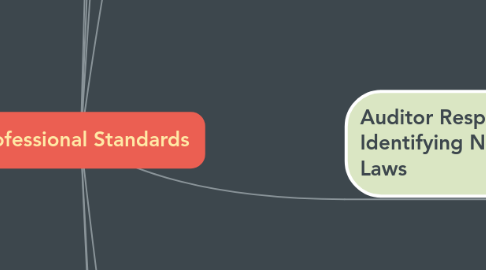
1. Authority of Regulatory Bodies
1.1. AICPA/American Institute of Certified Public Accountants
1.1.1. Establish Auditing, Attestation, Quality Control, Independence Ethical, Accounting and Review Standards for engagements involving nonpublic companies
1.1.2. AICPA have authority based on federal legislation.
1.1.3. CPA firms may subject themselves to AICPA voluntary Peer Review Programs.
1.1.4. Peer Review Programs cover non public auditing practices of CPA firm inspected by the PCAOB.
1.2. PCAOB/Public Company Accounting Oversight Board
1.2.1. Establish Auditing, Attestation, Quality Control, Independence, Ethical Standards for audits of public companies
1.2.2. PCAOB have authority based on their acceptance by NASPA.
1.2.3. Register CPA Firms.
1.2.4. Inspections of the audits practices of reg. CPAs.
2. Principles Underlying a GAAS Audit (PPRPR)
2.1. Purpose of an audit
2.1.1. opinion on f/s are in accordance GAAP
2.2. Premise of an audit
2.2.1. Prepare f/s in accordance with (GAAP).
2.2.2. Provide auditor with needed information and unrestricted access
2.3. Personal responsibilities of the auditor
2.3.1. competence and capabilities to perform audit.
2.3.2. maintaining professional skepticism.
2.3.3. exercising professional judgment.
2.4. Auditor actions in performing the audit
2.4.1. Obtain reasonable assurance about whether f/s are free from error or fraud.
2.5. Reporting results of an audit
2.5.1. written report an opinion on findings.
2.5.2. opinion is on whether the f/s are in accordance GAAP.
2.5.3. statement that opinion cannot be expressed
3. The 10 Generally Accepted Auditing Standards
3.1. General Standards TIP
3.1.1. Training and proficiency.
3.1.2. Independence in mental attitude
3.1.3. Due professional care
3.2. Standards of Field Work PIC Auditor Must
3.2.1. adequately plan and properly supervise work
3.2.2. obtain a sufficient understanding of entity, and its environment, including internal control.
3.2.3. Obtain sufficient appropriate audit evidence.
3.3. Reporting Standards GCDE
3.3.1. State whether the f/s are presented in accordance with GAAP.
3.3.2. Identify circumstances in which GAAP not been consistently applied.
3.3.3. Informative disclosures are adequate.
3.3.4. state the degree of responsibility being assumed by the auditors by expressing an opinion or stating that one cannot be expressed, and the reason therefor.
4. Auditor Responsibility for the Detection of Errors and Fraud
4.1. Errors
4.1.1. Def.:Unintentional misstatements or omissions.
4.1.2. EX:Mistakes in processing accounting data, incorrect accounting estimates due to oversight, mistakes in application of GAAP.
4.2. Fraud
4.2.1. Def.:Intentional misstatements or omissions.
4.2.2. EX:Two types— fraudulent financial reporting and misappropriation of assets
4.3. Auditor Responsibility
4.3.1. Obtain information to assess the inherent risks and fraud risks
4.3.2. Assess the risk of errors and fraud
4.3.3. plan and perform the audit to obtain reasonable assurance
4.3.4. Exercise due care proper degree of professional skepticism to achieve reasonable assurance
5. Auditor Responsibility for Client Identifying Noncompliance with Laws
5.1. Direct effect
5.1.1. Violations of laws regulations having a material and direct on F/S.
5.1.2. EX: Tax laws
5.1.3. Auditor Responsibility Same as for errors
5.2. Other Laws
5.2.1. Violations of laws regulations nothaving a material and direct on F/S.
5.2.2. Auditor Responsibility
5.2.2.1. Be aware of possibility that they may have occurred.
5.2.2.2. Specific procedures: Inquire of management as to compliance Inspect correspondence with licensing or regulatory authorities
5.2.2.3. determining whether noncompliance with a law has occurred.
6. The AICPA Standard Auditors’ Report-
6.1. Sections
6.1.1. Title
6.1.2. Addressee
6.1.3. Content Sections (paragraphs)
6.1.3.1. Introductory (“We have audited”)
6.1.3.2. Management’s responsibility
6.1.3.3. Auditor’s Responsibility
6.1.3.4. Opinion Paragraph
6.1.4. Signature (firm name)
6.1.5. City and state of office issuing audit report
6.1.6. Date
6.2. Types of Auditors’ Reports
6.2.1. Standard unmodified report (unqualified per PCAOB standards)
6.2.1.1. Financial statements follow GAAP and auditor does not add additional commentary for any issue .
6.2.2. Unmodified with emphasis of matter (or other emphasis)
6.2.2.1. Example: A lack of consistency in application of accounting principles.
6.2.3. Qualified opinion
6.2.3.1. Scope limitation or departure from GAAP.
6.2.4. Adverse opinion
6.2.4.1. Departure from GAAP so significant that financial statements as a whole are misleading.
6.2.5. Disclaimer of opinion
6.2.5.1. Unable to arrive at an opinion due to a very significant scope limitation.
6.3. Public Company Audit Report
6.3.1. Title is “Report of Registered Independent Public Accounting Firm.”
6.3.2. Refers to standards of the PCAOB rather than GAAS.
6.3.3. Includes a paragraph that refers to report on internal control.
6.3.4. Somewhat more brief than the nonpublic company report.
7. 11 ATTESTATION STANDARDS SSAE
7.1. Attestation Services
7.1.1. Financial Forecasts & Projections
7.1.2. Internal Control.
7.1.3. Pro Forma Financial Information
7.1.4. Compliance with Laws & Regulations.
7.1.5. Agreed Upon Preocedures
7.2. SSAE
7.2.1. General Standards -The practitioner
7.2.1.1. Training and proficiency.
7.2.1.2. Independence in mental attitude
7.2.1.3. Due professional care
7.2.1.4. adequate knowledge in the subject matter of the assertion.
7.2.1.5. perform an engagement only if he or she has reason to believe that the subject matter is capable of reasonably consistent evaluation against criteria that are suitable and available.
7.2.2. Standards of Field Work PIC Auditor Must
7.2.2.1. adequately plan and properly supervise work.
7.2.2.2. Obtain sufficient appropriate audit evidence.
7.2.3. Reporting Standards
7.2.3.1. identify the subject matter or the assertion being reported.
7.2.3.2. state the practitioner’s conclusion about the subject matter or the assertion in relation to the criteria.
7.2.3.3. state all of the practitioner’s significant reservations about the engagement, the subject matter.
7.2.3.4. state that the use of the report is restricted to specified parties When the report is on an attest engagement to apply agreed upon procedures to the subject matter.
